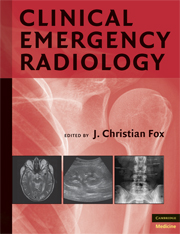Book contents
- Frontmatter
- Contents
- Contributors
- PART I PLAIN RADIOGRAPHY
- PART II ULTRASOUND
- 12 Introduction to Bedside Ultrasound
- 13 Physics of Ultrasound
- 14 Biliary Ultrasound
- 15 Trauma Ultrasound
- 16 Deep Venous Thrombosis
- 17 Cardiac Ultrasound
- 18 Emergency Ultrasonography of the Kidneys and Urinary Tract
- 19 Ultrasonography of the Abdominal Aorta
- 20 Ultrasound-Guided Procedures
- 21 Abdominal—Pelvic Ultrasound
- 22 Ocular Ultrasound
- 23 Testicular Ultrasound
- 24 Abdominal Ultrasound
- 25 Emergency Musculoskeletal Ultrasound
- 26 Soft Tissue Ultrasound
- 27 Ultrasound in Resuscitation
- PART III COMPUTED TOMOGRAPHY
- PART IV MAGNETIC RESONANCE IMAGING
- Index
- Plate Section
17 - Cardiac Ultrasound
from PART II - ULTRASOUND
Published online by Cambridge University Press: 07 December 2009
- Frontmatter
- Contents
- Contributors
- PART I PLAIN RADIOGRAPHY
- PART II ULTRASOUND
- 12 Introduction to Bedside Ultrasound
- 13 Physics of Ultrasound
- 14 Biliary Ultrasound
- 15 Trauma Ultrasound
- 16 Deep Venous Thrombosis
- 17 Cardiac Ultrasound
- 18 Emergency Ultrasonography of the Kidneys and Urinary Tract
- 19 Ultrasonography of the Abdominal Aorta
- 20 Ultrasound-Guided Procedures
- 21 Abdominal—Pelvic Ultrasound
- 22 Ocular Ultrasound
- 23 Testicular Ultrasound
- 24 Abdominal Ultrasound
- 25 Emergency Musculoskeletal Ultrasound
- 26 Soft Tissue Ultrasound
- 27 Ultrasound in Resuscitation
- PART III COMPUTED TOMOGRAPHY
- PART IV MAGNETIC RESONANCE IMAGING
- Index
- Plate Section
Summary
INDICATIONS
Cardiac ultrasound, or echocardiography, can be one of the most powerful noninvasive diagnostic tools available to the clinician in emergency situations involving critically ill or potentially critically ill patients (1–4).
The most dramatic indication for echo is the “code” or “near-code” situation, when a patient presents with pulseless electrical activity or severe hypotension (5,6). Echo may quickly establish whether there is significant left ventricular (LV) dysfunction, marked volume depletion, cardiac tamponade, or severe right ventricular (RV) outflow obstruction. Echo may also confirm cardiac standstill, or reveal evidence of fibrillation when the tracing appears to show asystole (7,8). Echo is an integral part of the focused assessment with sonography in trauma (FAST) examination and is particularly important in the setting of penetrating chest trauma (9).
Echo should be considered in any medical patient with signs or symptoms of a significant pericardial effusion. Effusion may present with isolated chest pain, tachycardia, hypotension, or dyspnea (10,11). Echo should be strongly considered in patients presenting with acute complaints and particular risk factors for effusion, such as malignancy or renal failure.
In many emergent conditions, echo may be a useful tool, but it should not be used in isolation to rule out the condition.
Keywords
- Type
- Chapter
- Information
- Clinical Emergency Radiology , pp. 254 - 267Publisher: Cambridge University PressPrint publication year: 2008

